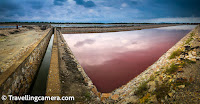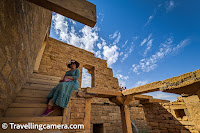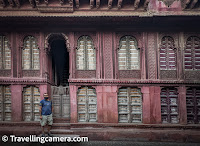City Palace is one among the marvelous architectural essences of Rajasthan and a jewel to Jaipur's royal heritage. Constructed in 1727 by Maharaja Sawai Jai Singh II, who himself established Jaipur, the palace complex is situated in the very heart of the Pink City and designed to be the administrative as well as ceremonial seat of the Maharaja of Jaipur. The City Palace has been transformed and extended for centuries but still blends well in the mix of Rajput, Mughal, and European architectural styles that express grandeur and elegance.
History of City Palace:
The construction of the City Palace began in 1727, which is actually the year it was founded. Maharaja Sawai Jai Singh II shifted his capital from Amber Fort to Jaipur and envisaged this palace as his new capital and seat of power. As the political and cultural center of Jaipur, this palace served as the seat of administration for the princely state. Over the centuries, different rulers have enhanced and added new buildings to the complex, leaving reflections of the elegant add-ons from those periods.
Architecture Design
The City Palace is a vast complex etched with a perfect amalgamation of Rajput, Mughal, and European styles, rendering the palace simply enchanting in terms of artistic creations and architectural marvels. The architecture of this palace is divided into a series of courtyards, gardens, and buildings.
Key Architectural Features:
Mubarak Mahal Mubarak Mahal is one of the most significant structures within the City Palace. This building was of the late 19th century and was designed by Maharaja Madho Singh II. It has been believed as a reception center for the foreign guests and dignitaries who were coming to visit the royal court. The architectural style of the building represents the mergence of Islamic, Rajput, and European art of architecture in its elegant marble façade and intricately carved arches.
Chandra Mahal: The Chandra Mahal is one of the main buildings in the palace complex, being the Jaipur royal family's residence. This seven storied building has each floor differently designed and used, providing beautifully decorated rooms with the Sukh Niwas, Rang Mandir, and the Shobha Niwas. The frescoes, mirrors, and floral designs in this building give evidence to the richness of Rajasthani art.
Pitam Niwas Chowk: This is the courtyard famous for four beautifully crafted gates. Each of them represents a season along with a Hindu god.
The Peacock Gate: Representing autumn, this gate is dedicated to Lord Vishnu.
The Lotus Gate: Representing summer, it's dedicated to Lord Shiva, and Parvati.
Green Gate: Also called the Leheriya Gate, which is representing spring with Lord Ganesha in mind.
The Rose Gate: It depicts winter, dedicated to the Goddess Devi.
They are intricately decorated with colorful motifs and paintings that emboss the artistry of Jaipur artisans.
Diwan-i-Khas (Hall of Private Audience): This is a private meeting hall between the Maharaja and his courtiers or foreign guest. It contains two enormous silver vessels each weighing 340 kgs that is considered to be the largest silver vessel in the world. These were used by Maharaja Madho Singh II to carry Ganga water while visiting England.
Diwan-i-Aam (Hall of Public Audience): The Diwan-i-Aam was a place for the public ceremony and official work. It is depicted through rich gold and red decorations on the ceiling and lavish chandeliers along with antique carpets, which shows the richness of the royal court.
Museums and Galleries
City Palace houses several museums that project into the life of the royals and the cultural heritage of Jaipur:
Maharaja Sawai Man Singh II Museum: The museum contains a great collection of objects, which comprises royal costumes and its varieties, such as several textiles, traditional armaments, and miniature paintings for centuries. Under the Textile Gallery are the garments the Maharajas wore-the elaborate shawls, saris, and turbans that represent Rajasthani craftsmanship.
Armoury Gallery: This gallery has a vast collection of medieval arms and armours of Rajput warriors, swords, daggers, spears, guns etc. Some of them with precious stones and detailed engravings exemplify the martial traditions that prevail here.
Baggi Khana: This is the part of the palace which exhibits the lavishly decorated carriages and chariots used by the royal family. Among the most notable is the Victoria Baggi, given as a gift to the Maharaja by the British.
Cultural Significance
City Palace is not a mere architectural wonder but has also been a cultural center and has much to do with keeping Jaipur's wonderful past alive. There is always something going on here: festivals, cultural events, and exhibitions throughout the year. Among the biggest celebrations here are the Gangaur Festival and Teej Festival, participated in with full fervor, where one sees exclusive traditional dances, music, and rituals. The royal residence today
Today, part of the Chandra Mahal remains a residential hall for Jaipur's royal family. Many parts of the palace remain open to public view, but the people are not allowed in some parts of the Chandra Mahal as it is inhabited by members of the blue blood family. The Sawai Man Singh II Museum Trust maintains and guards the palace so that its beauty will be there for generations to come in the name of great and glorious Jaipur heritage.
Tips for Visitors
The best time to visit the City Palace is in winters, that is, from October to March. The weather of these months is just apt for visiting the place.
A guide should be hired so that the visitor can gain all the knowledge related to its history, architecture, and stories that are associated with each section of the palace.
Photography: Taking photos is permitted anywhere except in some parts of the palace. Please carry your camera for all the heavenly architectural splendour and the detailing that goes into it.
Entry Tickets: Indian National, Foreign National:
Indian national Rs. 150.
Chandra Mahal - Photography is not allowed but ticket is available. Entry into the Chandra Mahal is separately allowed.
The City Palace in Jaipur can be characterized as something beyond being a monument of history; it is more of a symbol of the cultural heritage and erstwhile grandeur of Rajasthan. In every sense, from architectural splendor to magnificent courtyards and fine work of art, it reveals the household traditions and lifestyle of the Jaipur royal family. The experience is both exciting and enchanting, instructive and promising to be as well it all along has been to architecture enthusiasts, history buffs, or curious travelers to this visitor's case at least-end This promises an eternally timeless elegance in the legacy of the royal house of Jaipur.
Related Blogposts:
 Amber Fort in Rajasthan : The Pearl of Jaipur's Rajput Architecture
Amber Fort in Rajasthan : The Pearl of Jaipur's Rajput Architecture
 Chand Baori in Abhaneri: A Marvel of Ancient Indian Architecture in Rajasthan
Chand Baori in Abhaneri: A Marvel of Ancient Indian Architecture in Rajasthan
 Bhandarej Baori: An Ancient Stepwell of Rajasthan's Heritage
Bhandarej Baori: An Ancient Stepwell of Rajasthan's Heritage
.jpg) Tour de Churu Streets having grand havelis with marvelous fresco paintings | Haveli Heritage Tour Rajasthan, India
Tour de Churu Streets having grand havelis with marvelous fresco paintings | Haveli Heritage Tour Rajasthan, India
 Beautiful Vyas Chhatris in Jaisalmer, Rajasthan || the most unusual sunset point built in a cremation ground
Beautiful Vyas Chhatris in Jaisalmer, Rajasthan || the most unusual sunset point built in a cremation ground
 Magnificent Cenotaphs at the Bada Bagh, Jaisalmer, Rajasthan || Exorbitant Ticket Prices can be a deterrent to anyone visiting the place
Magnificent Cenotaphs at the Bada Bagh, Jaisalmer, Rajasthan || Exorbitant Ticket Prices can be a deterrent to anyone visiting the place
 An interesting drive from Kuldhara to Khaba Fort, Dedha, Jaisalmer, Rajasthan || The Journey was definitely worth the visit to this beautiful little fort
An interesting drive from Kuldhara to Khaba Fort, Dedha, Jaisalmer, Rajasthan || The Journey was definitely worth the visit to this beautiful little fort
 A half day detour to Sambhar Salt Lake, Rajasthan from NH48 || What makes India's Largest Inland Salt Lake worth visiting in winters?
A half day detour to Sambhar Salt Lake, Rajasthan from NH48 || What makes India's Largest Inland Salt Lake worth visiting in winters?
 A fulfilling stop at Mandore in Jodhpur, Rajasthan || The old seat of the Rathore clan and also the birthplace of Mandodari
A fulfilling stop at Mandore in Jodhpur, Rajasthan || The old seat of the Rathore clan and also the birthplace of Mandodari
 The Golden Fort of Jaisalmer, Rajasthan || A thriving, pulsating mini city within the walls of the fort
The Golden Fort of Jaisalmer, Rajasthan || A thriving, pulsating mini city within the walls of the fort
 The splendid architecture of Patwon ki Haveli in Jaisalmer, Rajasthan || One of the most opulent of the havelis in Jaisalmer
The splendid architecture of Patwon ki Haveli in Jaisalmer, Rajasthan || One of the most opulent of the havelis in Jaisalmer
 The Abandoned Village of Kuldhara near Jaisalmer, Rajasthan || Facts and Fables about why the Paliwal Brahmins abandoned this village of their ancestors
The Abandoned Village of Kuldhara near Jaisalmer, Rajasthan || Facts and Fables about why the Paliwal Brahmins abandoned this village of their ancestors
 The Amazing Pokaran Fort near Jaisalmer, Rajasthan || A beautiful structure that effortlessly blends with the desert landscape it is built in
The Amazing Pokaran Fort near Jaisalmer, Rajasthan || A beautiful structure that effortlessly blends with the desert landscape it is built in
 Vedi Temple inside KumbalGarh Fort, Rajasthan - 3 Storey Octagonal structure standing strong on 36 pillars around world's second largest wall
Vedi Temple inside KumbalGarh Fort, Rajasthan - 3 Storey Octagonal structure standing strong on 36 pillars around world's second largest wall



.jpg)
















.jpg)

.jpg)
Comments